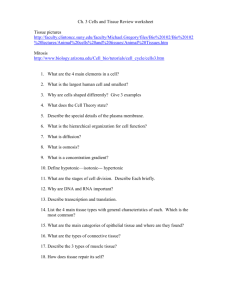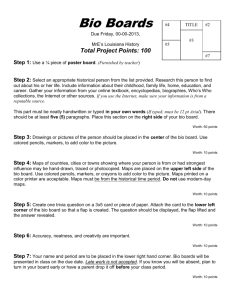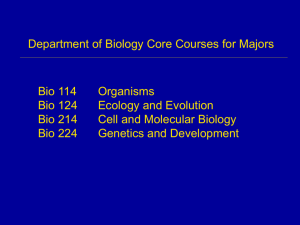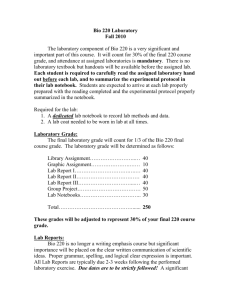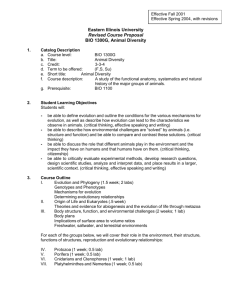BIO 100
advertisement
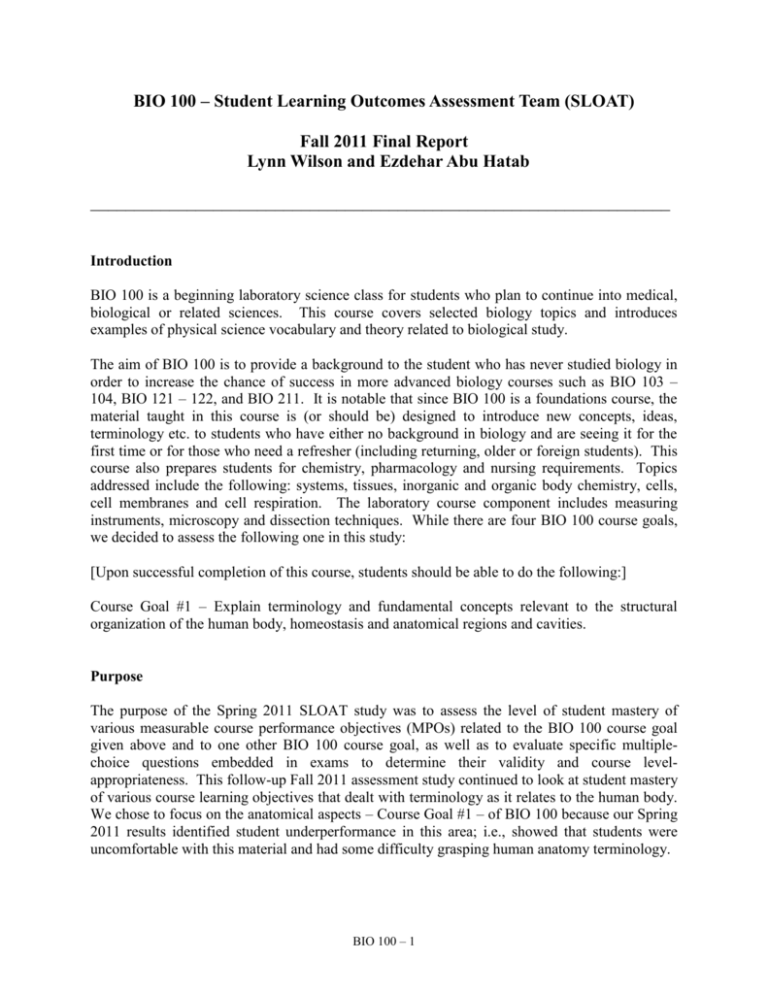
BIO 100 – Student Learning Outcomes Assessment Team (SLOAT) Fall 2011 Final Report Lynn Wilson and Ezdehar Abu Hatab __________________________________________________________________ Introduction BIO 100 is a beginning laboratory science class for students who plan to continue into medical, biological or related sciences. This course covers selected biology topics and introduces examples of physical science vocabulary and theory related to biological study. The aim of BIO 100 is to provide a background to the student who has never studied biology in order to increase the chance of success in more advanced biology courses such as BIO 103 – 104, BIO 121 – 122, and BIO 211. It is notable that since BIO 100 is a foundations course, the material taught in this course is (or should be) designed to introduce new concepts, ideas, terminology etc. to students who have either no background in biology and are seeing it for the first time or for those who need a refresher (including returning, older or foreign students). This course also prepares students for chemistry, pharmacology and nursing requirements. Topics addressed include the following: systems, tissues, inorganic and organic body chemistry, cells, cell membranes and cell respiration. The laboratory course component includes measuring instruments, microscopy and dissection techniques. While there are four BIO 100 course goals, we decided to assess the following one in this study: [Upon successful completion of this course, students should be able to do the following:] Course Goal #1 – Explain terminology and fundamental concepts relevant to the structural organization of the human body, homeostasis and anatomical regions and cavities. Purpose The purpose of the Spring 2011 SLOAT study was to assess the level of student mastery of various measurable course performance objectives (MPOs) related to the BIO 100 course goal given above and to one other BIO 100 course goal, as well as to evaluate specific multiplechoice questions embedded in exams to determine their validity and course levelappropriateness. This follow-up Fall 2011 assessment study continued to look at student mastery of various course learning objectives that dealt with terminology as it relates to the human body. We chose to focus on the anatomical aspects – Course Goal #1 – of BIO 100 because our Spring 2011 results identified student underperformance in this area; i.e., showed that students were uncomfortable with this material and had some difficulty grasping human anatomy terminology. BIO 100 – 1 Methodology For this assessment study, one section of BIO 100 was used – Section 001 – which was taught by a full-time faculty member. After covering one of the major topics included in the Introduction Chapter of the text used for this course, a total of 24 students were given an assessment activity handout entitled Maintaining Life (see Appendix A of this report) and were then asked to match the items from Column A (definitions of systems of the body) with answers from Column B (the names of the systems of the body). Note that since this topic is taught at the beginning of the semester, the assessment activity handout was distributed during the second week of classes. In addition, the first four chapters of the current Anatomy and Physiology text book are covered in BIO 100 because these chapters contain information on basic topics that are universal to both A&P I (BIO 121) and General Biology I (BIO 103). Results The student learning outcomes data collected during this study consists of the results of the Maintaining Life assessment activity. Student performance on each matching question was examined to determine specifically which topics were most difficult for students to grasp. (See Appendix B of this report.) Unfortunately, because this handout was considered supplemental to course requirements, only 13 of the 24 students completed and handed in the assignment. From the graph detailing student performance on the assessment handout questions included in Appendix B, it is obvious that overall, students did very well on these questions. Based on these results, it is possible to conclude then that many students achieved BIO 100 Course Goal #1. We found that most students did well on the majority of the questions, and that only a few students had some difficulty with at least one aspect of the assignment. Specifically, 6 of the 13 (46%) students who completed the assignment answered all (9 out of 9) questions correctly; 3 students (23%) answered 8 out of 9 questions correctly; and the remaining 4 students (31%) answered 7 out of 9 questions correctly. Of the 9 questions on the handout, question #9 gave students the most trouble. It stated “At the cellular level, membranes; for the whole organism, the skin.” Its answer was “Maintenance of Boundaries.” In order for students to grasp the concept of boundaries as it pertains to the human body and to draw correlations between two seemingly separate objects, including critical thinking exercises and/or interactive software would be helpful in the course. Furthermore, exploding models (Bioflix) would aid students in seeing the components of the human body at different levels. Exploring the use of technology in the classroom, such as iPads and other appropriate digital devices used by students and faculty might also aid in increasing student knowledge as well as in conducting student outcome assessments. Conclusion In examining the collected SLO assessment data, there are some considerations that must be taken as well as some conclusions that may be drawn. One such consideration is that the course BIO 100 – 2 was taught by a full-time professor who was familiar with the course and also with the students who populate the course. Having taught the course for many years and having gained an understanding of the students and their academic goals, the professor made sure that the subject matter was presented to the pupils in a manner that may have made it possible to do well on the assessment activity assignment. The students were not only given a lecture on anatomical terminology, but the information was reinforced by reviewing the information at the end of the lecture and answering any questions posed that pertained to the topic. In addition, extra work was given, such as a handout of examples of the function of systems of the body. This may have affected the collected student learning outcomes assessment data of this study. Lastly, BIO 100 is considered a “supplemental course” in that students who take Foundations of Biology are usually looking to advance to more difficult or rigorous courses such as Anatomy and Physiology, General Biology and other higher-level biology courses. In order to prepare students for these challenging subjects, it is necessary that they be able to think critically about concepts in biology. By implementing in the course some of the suggestions mentioned above, students who pass BIO 100 successfully will be better prepared to compete with others in the higher-level courses and later in their chosen fields of study. BIO 100 – 3 APPENDIX A – BIO 100 Maintaining Life Assessment Activity Handout Directions: Match the terms pertaining to functional characteristics of organisms in Column B with the appropriate descriptions in Column A. Fill in the answer blanks with the appropriate letter or term. Column A Column B _________ 1. Keeps the body’s internal environment distinct from the external environment A. Digestion _________ 2. Provides new cells for growth and repair B. Excretion _________ 3. Occurs when constructive activities occur C. Growth _________ 4. The tuna sandwich you have just eaten is broken down to its chemical building blocks D. Maintenance of Boundaries _________ 5. Elimination of carbon dioxide by the lungs and elimination of nitrogenous wastes by the kidneys E. Metabolism _________ 6. Ability to react to stimuli; a major role in the nervous system F. Movement _________ 7. Walking, throwing a ball, riding a bicycle G. Responsiveness _________ 8. All chemical reactions occurring in the body H. Reproduction _________ 9. At the cellular level, membranes; for the whole organism, the skin BIO 100 – Appendix A – 1 APPENDIX B – BIO 100 Maintaining Life Assessment Activity Handout Results 13 12 # 11 10 o f S t u d e n t s 9 # of Correct Responses 8 7 6 # of Incorrect Responses 5 4 3 2 1 0 1 2 3 4 5 6 7 Question # Question # 1 2 3 4 5 6 7 8 9 System of the Body Responsiveness Growth Reproduction Digestion Excretion Responsiveness Movement Metabolism Maintenance of Boundaries BIO 100 – Appendix B – 1 8 9
